The automotive landscape is rich with options for consumers looking for compact SUVs, and two popular models that often come into the spotlight are the BMW X1 and the Ford Kuga. Both vehicles offer an appealing mix of performance, comfort, and technology, but they cater to slightly different markets. In this comparison, we will delve into their technical specifications, innovations, and overall driving experience to help you make an informed decision.
BMW X1 vs Ford Kuga – Which one offers the better deal?
Compare performance, boot capacity, efficiency and price at a glance.
Find out which car is the better choice for you – BMW X1 or Ford Kuga?
Powertrain Options and Performance
The BMW X1 boasts a versatile lineup of engine types, including petrol, diesel, and hybrid options. The available power outputs range from 136 HP to a notable 326 HP, depending on the variant, which contributes to a robust performance across the board. Acceleration from 0 to 100 km/h can be achieved in as little as 5.4 seconds, showing that the X1 can hold its own in terms of sporty driving attributes.
On the other hand, the Ford Kuga features a selection of petrol and hybrid engines with power outputs from 150 HP up to 243 HP. While its acceleration figures aren’t as stellar as those of the X1—with the quickest variant reaching 0 to 100 km/h in 7.3 seconds—the Kuga makes up for it with a harmonious balance between efficiency and practicality.
Fuel Efficiency and Emissions
When it comes to fuel consumption, the BMW X1 offers an impressive range, with some variants as efficient as 4.6 L/100 km. However, the Ford Kuga shows commendable figures too, with certain hybrid versions achieving a remarkable consumption rate of just 5.3 L/100 km. Both vehicles have made strides in reducing CO2 emissions, but the Kuga nudges ahead with some versions boasting a CO2 output as low as 122 g/km versus the X1’s minimal of 120 g/km for its cleaner options.
Interior Comfort and Tech Innovations
The interior of the BMW X1 is a blend of luxury and functionality, featuring high-quality materials and a well-executed layout. The infotainment system, anchored by BMW's iDrive technology, is intuitive and user-friendly, supporting both Apple CarPlay and Android Auto. Its trunk capacity varies depending on the configuration but can reach up to 540 liters, making it a champion for practicality.
The Ford Kuga, while not as opulent as the X1, offers a spacious cabin filled with practical features. Its infotainment system, known as Ford SYNC, is straightforward and efficient, allowing drivers to connect devices seamlessly. However, the trunk space is slightly smaller at 412 liters, which may be a consideration for families or those needing extra cargo capacity.
Driving Dynamics and Comfort
The BMW X1 is renowned for its sporty handling and composed ride quality. Its all-wheel-drive option enhances grip and stability, making it suitable for both urban commuting and adventurous terrains. The various driving modes available also allow drivers to tailor the vehicle's dynamics to suit their preferences.
Conversely, the Ford Kuga prioritizes comfort and ease of handling. While it may not deliver the same sportiness as the X1, it provides a smooth ride with engaging steering. The Kuga is particularly user-friendly in city driving, making it an excellent choice for daily commuters.
Pricing and Value
Price-wise, the BMW X1 generally sits in a higher segment compared to the Ford Kuga. The luxury branding, advanced technology, and build quality justifies the premium, but it might not be the most budget-friendly option. Conversely, the Ford Kuga represents a more accessible choice for those seeking reliability and modern features without breaking the bank.
Conclusion
In summary, the choice between the BMW X1 and the Ford Kuga ultimately hinges on your priorities. If you're seeking a dynamic driving experience, luxury finishes, and cutting-edge technology, the X1 is a compelling choice. However, if you need a practical, efficient, and cost-effective SUV for everyday use, the Kuga stands out as a strong contender. Whichever vehicle you choose, both the X1 and Kuga demonstrate that the compact SUV segment has something to offer for everyone.
Here’s where it gets real: The technical differences in detail
Costs and Efficiency:
When it comes to price and running costs, the biggest differences usually appear. This is often where you see which car fits your budget better in the long run.
Ford Kuga has a a bit advantage in terms of price – it starts at 34200 £, while the BMW X1 costs 38200 £. That’s a price difference of around 3986 £.
Fuel consumption also shows a difference: BMW X1 manages with 2.50 L and is therefore slightly more efficient than the Ford Kuga with 2.80 L. The difference is about 0.30 L per 100 km.
As for range, the BMW X1 performs a bit better – achieving up to 81 km, about 13 km more than the Ford Kuga.
Engine and Performance:
Power, torque and acceleration are the classic benchmarks for car enthusiasts – and here, some clear differences start to show.
When it comes to engine power, the BMW X1 has a distinct edge – offering 326 HP compared to 243 HP. That’s roughly 83 HP more horsepower.
In acceleration from 0 to 100 km/h, the BMW X1 is distinct quicker – completing the sprint in 5.40 s, while the Ford Kuga takes 7.30 s. That’s about 1.90 s faster.
In terms of top speed, the BMW X1 performs to a small extent better – reaching 250 km/h, while the Ford Kuga tops out at 200 km/h. The difference is around 50 km/h.
There’s also a difference in torque: BMW X1 pulls decisively stronger with 477 Nm compared to 240 Nm. That’s about 237 Nm difference.
Space and Everyday Use:
Whether family car or daily driver – which one offers more room, flexibility and comfort?
Both vehicles offer seating for 5 people.
In curb weight, Ford Kuga is hardly perceptible lighter – 1526 kg compared to 1575 kg. The difference is around 49 kg.
In terms of boot space, the BMW X1 offers distinct more room – 540 L compared to 412 L. That’s a difference of about 128 L.
In maximum load capacity, the BMW X1 performs slight better – up to 1600 L, which is about 66 L more than the Ford Kuga.
When it comes to payload, Ford Kuga slight takes the win – 550 kg compared to 500 kg. That’s a difference of about 50 kg.
Who comes out on top?
Overall, the BMW X1 shows itself to be wins the duel decisively and secures the title of DriveDuel Champion.
It convinces with the more balanced overall package and proves to be the more versatile choice for everyday use.
 @ BMW Group Press
@ BMW Group Press
BMW X1
BMW X1
The BMW X1 brings a premium feel to compact crossover life, wrapping practical space and agile handling into a tidy, upscale package. It’s ideal for buyers who want BMW driving dynamics without the bulk, offering everyday comfort and a few clever tricks to keep the commute interesting.
details @ BMW Group Press
@ BMW Group Press
 @ BMW Group Press
@ BMW Group Press
 @ BMW Group Press
@ BMW Group Press
 @ BMW Group Press
@ BMW Group Press
 @ BMW Group Press
@ BMW Group Press
Ford Kuga
The Kuga is Ford’s adaptable family SUV that blends usable space with a surprisingly lively driving character, making daily commutes and weekend escapes equally enjoyable. With smart interior packaging, an easy-to-use infotainment setup and composed road manners, it’s a sensible choice for buyers who want a bit of fun without the fuss.
details @ Ford Motor Company / Ford Media Center
@ Ford Motor Company / Ford Media Center
 @ Ford Motor Company / Ford Media Center
@ Ford Motor Company / Ford Media Center
 @ Ford Motor Company / Ford Media Center
@ Ford Motor Company / Ford Media Center
 @ BMW Group Press
@ BMW Group Press
|
 @ Ford Motor Company / Ford Media Center
@ Ford Motor Company / Ford Media Center
|
|
|
|
Costs and Consumption |
|
|---|---|
|
Price
38200 - 55500 £
|
Price
34200 - 46300 £
|
|
Consumption L/100km
2.5 - 7.7 L
|
Consumption L/100km
2.8 - 6.8 L
|
|
Consumption kWh/100km
-
|
Consumption kWh/100km
-
|
|
Electric Range
81 km
|
Electric Range
68 km
|
|
Battery Capacity
14.20 kWh
|
Battery Capacity
1.1 - 14.4 kWh
|
|
co2
57 - 175 g/km
|
co2
55 - 154 g/km
|
|
Fuel tank capacity
47 - 54 L
|
Fuel tank capacity
42 - 54 L
|
Dimensions and Body |
|
|---|---|
|
Body Type
SUV
|
Body Type
SUV
|
|
Seats
5
|
Seats
5
|
|
Doors
5
|
Doors
5
|
|
Curb weight
1575 - 1935 kg
|
Curb weight
1526 - 1859 kg
|
|
Trunk capacity
490 - 540 L
|
Trunk capacity
412 L
|
|
Length
4500 - 4505 mm
|
Length
4604 - 4645 mm
|
|
Width
1845 mm
|
Width
1882 mm
|
|
Height
1622 - 1642 mm
|
Height
1673 - 1681 mm
|
|
Max trunk capacity
1495 - 1600 L
|
Max trunk capacity
1534 L
|
|
Payload
490 - 500 kg
|
Payload
541 - 550 kg
|
Engine and Performance |
|
|---|---|
|
Engine Type
Diesel MHEV, Petrol MHEV, Petrol, Diesel, Plugin Hybrid
|
Engine Type
Petrol, Full Hybrid, Plugin Hybrid
|
|
Transmission
Automatic
|
Transmission
Manuel, Automatic
|
|
Transmission Detail
Dual-Clutch Automatic
|
Transmission Detail
Manual Gearbox, CVT, Automatic Gearbox
|
|
Drive Type
Front-Wheel Drive, All-Wheel Drive
|
Drive Type
Front-Wheel Drive, All-Wheel Drive
|
|
Power HP
136 - 326 HP
|
Power HP
150 - 243 HP
|
|
Acceleration 0-100km/h
5.4 - 9.2 s
|
Acceleration 0-100km/h
7.3 - 9.9 s
|
|
Max Speed
190 - 250 km/h
|
Max Speed
195 - 200 km/h
|
|
Torque
230 - 477 Nm
|
Torque
240 Nm
|
|
Number of Cylinders
3 - 4
|
Number of Cylinders
3 - 4
|
|
Power kW
100 - 240 kW
|
Power kW
111 - 178 kW
|
|
Engine capacity
1499 - 1998 cm3
|
Engine capacity
1496 - 2488 cm3
|
General |
|
|---|---|
|
Model Year
2024 - 2025
|
Model Year
2025
|
|
CO2 Efficiency Class
D, E, F, B
|
CO2 Efficiency Class
E, D, B
|
|
Brand
BMW
|
Brand
Ford
|
Is the BMW X1 offered with different drivetrains?
The BMW X1 is offered with Front-Wheel Drive or All-Wheel Drive.
The prices and data displayed are estimates based on German list prices and may vary by country. This information is not legally binding.
